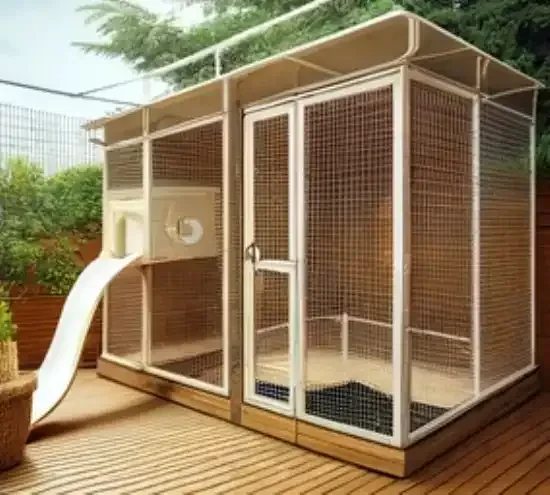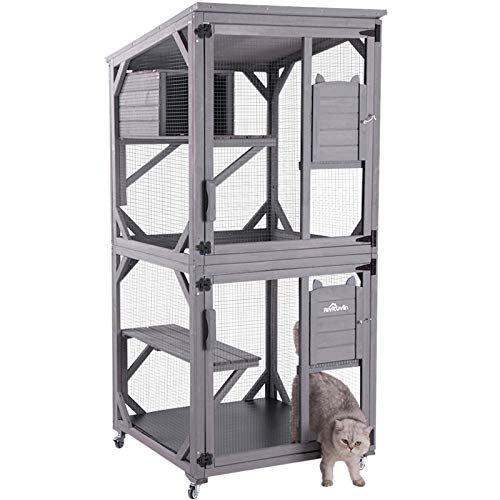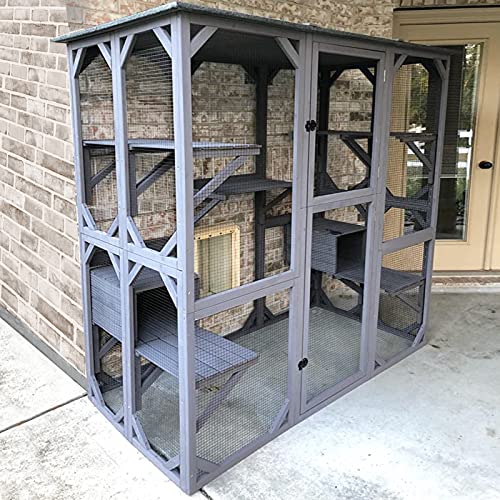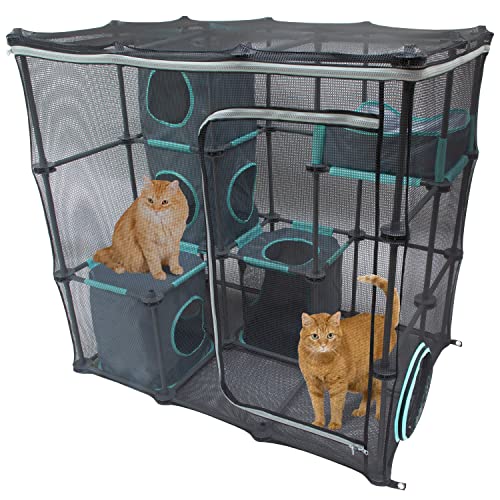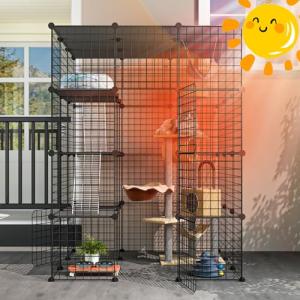Imagine your cat, perched elegantly on the windowsill, eyes wide, tail twitching, utterly captivated by the fluttering leaves and the distant chirping of birds. It's a scene played out in homes across the world – our feline companions drawn to the allure of the outdoors, a realm of sensory richness and natural instincts. Yet, as much as we might wish to grant them the freedom of exploration, the reality of the outside world for a domestic cat is fraught with perils. Busy roads, territorial dogs, cunning predators, contagious diseases, and the simple risk of becoming lost are just a few of the hazards that lurk beyond our doorsteps. This creates a challenging dilemma for cat lovers: how do we reconcile our desire to protect our beloved pets with their innate yearning for the natural world? The answer, increasingly embraced by responsible cat owners, lies in the creation of safe outdoor enclosures, often affectionately termed "catios." These purpose-built spaces offer the perfect compromise, allowing cats to revel in the joys of the outdoors while remaining shielded from harm. This article will delve into the world of safe outdoor enclosures, exploring the myriad benefits they offer, the diverse types available, the key considerations for design and construction, the art of enriching these spaces for feline delight, and ultimately, why investing in a catio is an investment in your cat's happiness, health, and your own peace of mind.
Why, you might ask, should you consider building a safe haven outdoors for your cat? The reasons are compelling and fall broadly into two categories: safety and enrichment. Firstly, and most importantly, is the paramount concern for your cat's well-being. The list of dangers facing free-roaming cats is unfortunately extensive. Cars are an obvious threat, but so too are predators, depending on your geographical location. Coyotes, foxes, raccoons, even larger birds of prey can pose a danger to domestic cats. Domestic dogs, even well-meaning ones, can unintentionally injure or scare a cat. Diseases such as feline immunodeficiency virus (FIV), feline leukemia virus (FeLV), and rabies are far more prevalent outdoors. Parasites, both internal and external, are a constant risk. Then there are the insidious dangers of toxins – from antifreeze spills to poisonous plants and pesticides used in gardens. And let's not forget the heartbreaking reality of lost cats; those who wander too far, become disoriented, or are unfortunately stolen. By providing a secure outdoor space, you eliminate or drastically reduce exposure to these dangers, potentially saving your cat from injury, illness, or worse. This translates not only to a happier, healthier cat but also, potentially, to reduced veterinary bills in the long run. Perhaps most significantly, building a safe enclosure offers immeasurable peace of mind to you, the owner. Knowing your cat is enjoying the fresh air and sunshine in a secure environment removes the constant worry and anxiety associated with letting them roam freely.
Beyond safety, outdoor enclosures provide vital enrichment that contributes significantly to a cat's overall well-being. For creatures instinctively wired to hunt, explore, and bask in the sun, indoor confinement, while safe, can sometimes feel limiting. A catio provides an outlet for these natural urges. Imagine your cat stalking a butterfly fluttering just beyond the mesh, or intently watching birds flitting amongst nearby branches – even in a protected environment, these experiences engage their hunting instincts. The constant flow of new sights, sounds, and smells in an outdoor setting provides invaluable mental stimulation, combating boredom and the potential for related behavioral issues that can arise from a lack of environmental enrichment. Physically, an outdoor enclosure encourages movement. Whether climbing a ramp to a higher perch, leaping between platforms, or simply pacing along a sun-drenched path, catios encourage physical exercise, crucial for maintaining a healthy weight and preventing the sedentary lifestyle that can be common for indoor cats. Access to the outdoors has also been shown to improve a cat’s mood and reduce stress. The sensory richness and connection to nature, however controlled, can have a profoundly positive effect on their emotional state. Ultimately, a catio isn't just about safety; it's about enriching your cat's life, providing a space where they can be their true feline selves, happily and healthily connected to the natural world.
Once you're convinced of the benefits, the next step is exploring the fascinating world of catio design. The beauty of outdoor enclosures lies in their versatility; there’s a type to suit almost every space, budget, and aesthetic preference. Perhaps the most well-known and versatile is the "catio" itself, short for cat patio. These are purpose-built structures, ranging from simple window boxes to elaborate garden extensions. Catios can be attached directly to your house, offering seamless indoor-outdoor access, or freestanding, creating a dedicated outdoor haven in your yard. Attached catios are particularly convenient, often accessed through a window or pet door, blurring the lines between indoor and outdoor space. Window box catios are ideal for those with limited space, offering a small, contained outdoor perch directly outside a window. Balcony or patio catios ingeniously utilize existing structures, enclosing balconies or patios with mesh to create safe, expansive outdoor areas. Garden catios, the most ambitious type, become integrated features of your landscaping, often larger and more elaborate, offering substantial outdoor space.
For those with larger yards and a desire to grant their cats more extensive roaming space, cat fencing or perimeter fencing presents an alternative. This specialized fencing is designed to prevent cats from climbing over or digging under, effectively containing them within a larger portion of your yard. While offering more space, perimeter fencing requires careful installation and may not be suitable for determined climbers. Tunnel systems offer a whimsical and enriching addition to any enclosure. These enclosed pathways can connect indoor spaces to outdoor catios, or link different sections of a larger enclosure, adding an element of adventure and exploration to your cat's outdoor experience. For homeowners with existing screened porches or sunrooms, these spaces can often be adapted to create safe cat enclosures. Screened porches offer a cost-effective and often already integrated option, needing only minor modifications to ensure cat safety. Finally, for renters, those with very limited space, or those seeking a more temporary solution, portable enclosures and playpens offer flexibility. These smaller, movable enclosures are readily available, often affordable, and can be easily relocated, although they generally provide less space and may not be as durable as permanent structures. Choosing the right type of enclosure is a personal decision, dependent on various factors. Consider the space available in your yard or on your property, your budget, your DIY skills, and importantly, your cat’s personality and activity level. A less active cat might be perfectly content with a smaller window box catio, while a more energetic feline might thrive in a larger garden catio or perimeter-fenced yard. Your own aesthetic preferences also play a role; do you want the enclosure to seamlessly blend with your home and garden, or are you prioritizing functionality above all else?
Regardless of the type you choose, safety must be the foundational principle of your catio design and construction. A secure structure is non-negotiable. This starts with strong framing, typically using wood or metal, depending on the size and style of the enclosure. The mesh or wire you choose is equally critical; it must be durable enough to withstand weather and resist determined scratching and climbing, with a proper gauge and spacing to prevent both escape and predator intrusion. A secure roof is essential, whether solid or mesh, depending on your climate and the type of enclosure. Escape-proofing is paramount. Design features like overhangs on walls prevent cats from climbing over, while burying wire mesh at the base deters digging. Secure doors and latches are crucial; choose cat-proof latches that cannot be easily manipulated by curious paws. Protection from the elements is another vital consideration. Provide ample shade, especially in warmer climates, using shade cloth or solid roof sections. Ensure protection from rain and wind, incorporating solid wall sections where needed. In colder climates, consider the potential for snow accumulation and design accordingly. Finally, always prioritize non-toxic materials. Choose safe wood treatments, paints, and mesh materials that are not harmful if chewed or scratched, ensuring the enclosure is a healthy environment for your feline friend.
Beyond safety, a functional and practical design enhances both your cat’s enjoyment and your own maintenance efforts. Size and space are key; ensure the enclosure is large enough for your cat to move comfortably, play, and relax. Consider the number of cats who will use the space and their individual activity levels. Vertical space is particularly important to cats. Think shelves, ramps, and cat trees to maximize the usable space and cater to their climbing instincts. Access for cleaning and maintenance is often overlooked but crucial for long-term enjoyment. Design easy access points for cleaning litter boxes, replenishing food and water, and general upkeep. Consider whether you also want owner access. Do you envision spending time with your cat in the enclosure? If so, incorporate a door or gate large enough for you to enter comfortably. Location and placement are also important considerations. Think about sunlight exposure and shade patterns throughout the day, proximity to your house for easy access, views from inside your house, and proper drainage to prevent water accumulation within the enclosure. And don't forget aesthetics! Consider materials and design elements that complement your home and garden, creating an enclosure that is both functional and visually appealing.
When it comes to construction, you have the choice between DIY and professional build. A DIY approach can be rewarding and cost-saving for those with the necessary skills and tools. Assess your woodworking or construction skills honestly, consider the tools required, and realistically estimate the time commitment involved. Numerous DIY catio plans are available online and in books, providing step-by-step guidance. Alternatively, hiring a professional catio builder or general contractor offers numerous benefits. Professionals bring expertise, save you time and effort, can create custom designs tailored to your specific needs and space, although this option typically comes with a higher upfront cost. Regardless of whether you DIY or hire a professional, it’s always wise to briefly check local regulations and Homeowner Association (HOA) rules regarding outdoor structures in your yard to avoid any unexpected issues down the line.
Once the structure is built, the real fun begins: transforming it into a feline paradise! Enrichment is the key to making your catio a space your cat truly loves and uses regularly. Remember, vertical space is king in the cat world. Maximize verticality by incorporating climbing structures like shelves, ramps, cat trees, climbing walls, even sturdy branches or ladders, allowing cats to ascend to different vantage points. Viewing platforms are equally crucial. Install high perches, platforms, or window boxes, offering your cat elevated spots to observe their surroundings, mimicking their natural desire to survey their territory from above. Sensory enrichment adds another layer of engagement. Introduce cat-safe plants like catnip, cat grass, valerian, or honeysuckle (always double-checking for non-toxic varieties and researching plant safety thoroughly – caution is paramount with plants in cat enclosures!). Hang bird feeders just outside the enclosure to provide visual stimulation and “prey” watching opportunities. If space and safety allow, incorporate water features like fountains or bird baths (under supervision), or even a small, safely enclosed pond. Provide a variety of scratching surfaces, such as scratching posts, logs, sisal mats, or cardboard scratchers, catering to different feline scratching preferences. Vary the textures underfoot within the enclosure using gravel, mulch, wood chips, or even patches of grass if feasible, adding tactile interest for your cat.
Don't forget comfort and relaxation zones. Include sheltered resting spots like cat houses, beds, or hammocks placed in shaded areas, offering refuge from sun and elements. Conversely, provide sunny platforms or areas for sunbathing for cats who enjoy basking in the warmth. Incorporate hideaways – covered areas, tunnels, or boxes – offering a sense of security and privacy where cats can retreat when they desire solitude. And of course, no cat paradise is complete without toys and play opportunities. Engage your cat with interactive toys like fishing rod toys, feather wands, or laser pointers (used responsibly, avoiding shining directly into their eyes). Introduce puzzle feeders or foraging toys to stimulate their natural hunting instincts. Hang dangling toys from perches or the enclosure roof, providing objects for them to bat at and play with independently.
Finally, to ensure your catio remains a safe and enjoyable space for years to come, regular maintenance is necessary. Establish a routine for cleaning, which includes scooping litter boxes daily, regularly cleaning surfaces, removing debris like fallen leaves, and washing food and water bowls frequently. Periodically conduct safety checks, inspecting the structure for any damage, loose mesh, or insecure latches, addressing any potential hazards promptly. If you’ve incorporated plants, ensure their ongoing care through watering, pruning, and replacing them as needed. If pests become an issue, explore safe pest control methods that won’t harm your cats. And as the seasons change, make seasonal adjustments, providing extra shade during hot summer months and adding windbreaks or sheltered areas in winter to ensure year-round usability.
In conclusion, creating a safe outdoor enclosure for your cat is more than just building a structure; it's about crafting an enriching environment that caters to their innate needs while prioritizing their safety and well-being. It's an investment that pays dividends in your cat's happiness, their physical and mental health, and in the immeasurable peace of mind it brings to you, knowing your feline companion is reveling in the joys of the outdoors, safely ensconced in their own purr-fect paradise. So, take inspiration from the ideas presented, consider your space and your cat's unique personality, and embark on the rewarding journey of creating an outdoor haven where your cat can truly thrive, connected to nature, yet always safe within your loving care.
